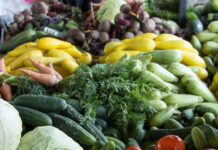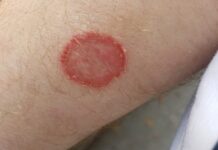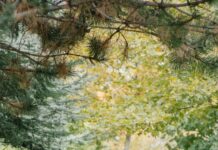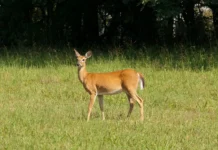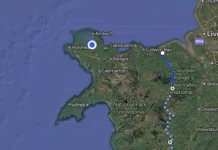Stephanie Carter, a MSc student at Aberystwyth University, has been undertaking research at the National Botanic Garden Wales, linked to the Mynydd Mawr Marsh Fritillary project. The research project investigated the butterfly’s food plant devil’s bit scabious (Succisa pratensis) and the conditions for its successful establishment. The results of the research will inform the Project on how to best re-introduce devil’s bit scabious into suitable habitat within the project area and where best to source seed so that it has the best chance of survival.
The marsh grassland habitat that the marsh fritillary depends up project area around Cross Hands is fragmented. Habitat fragmentation and isolation can impact upon plants’ genetic variability and reproductive fitness. The research investigated the status of devil’s bit scabious populations at a number of sites as well as the species’ germination requirements. Seeds were collected from 24 sites in south Wales, four sites in mid-Wales and one site in Ireland. Additionally, batches of seeds were acquired from commercial suppliers.
Seeds collected were germinated and grown on into seedlings. Three hundred seedlings were monitored for the strength of their growth at the Phenomics Centre at Gogerddan, Aberystwyth University. In addition of numbers of leaves were counted, plant height measured and vigour visually assessed.
Results showed that seeds from one site on Black Lion Road, Gorslas grew best. This population had a particularly high number of leaves, seedlings were taller than those of many other populations and scored high in terms of vigour. There was a positive link between seedling survival and the number of seeds produced, their weight and germination rate. It was also shown that seeds formed at the end of the growing season produce fewer seedlings or that the poor weather conditions then impact on seed viability.
The suggestions re propagating devil’s bit scabious included.
• Seed origin – source from large populations, harvest early in the season from the main seed head.
• Seed harvesting and drying – preferably collect seeds on a dry day and place directly into envelopes for drying, by keeping inside over winter.
• Germination – place seeds directly into cell trays and leaving trays outside from early March onwards preferably so they experience a frost (NB germination can be limited by fungal pathogens – application of fungicide would increase germination and seedling survival rate).
• Seedling establishment – It is recommended that a low fertile compost such as John Innes Seed Compost is used. Excessive fertilisation should be avoided as this has led to a reduction of surviving seedlings. Cell trays should be watered daily to minimize drought stress for the seedlings.
• Transplantation of plugs – turf removal aids seedling establishment and avoid planting in thick vegetation
Ymchwilio i damaid y cythraul ac i sut mae sicrhau bod y planhigyn yn ffynnu
Mae Stephanie Carter, sy’n fyfyrwraig MSc ym Mhrifysgol Aberystwyth, wedi bod yn gwneud gwaith ymchwil yng Ngardd Fotaneg Genedlaethol Cymru mewn perthynas â phrosiect Brithegion y Gors y Mynydd Mawr. Mae’r prosiect wedi bod yn ymchwilio i damaid y cythraul (Succisa pratensis), sef y planhigyn y mae brithegion y gors yn bwydo arno, ac i’r amgylchiadau addas ar ei gyfer. Bydd canlyniadau’r gwaith ymchwil yn rhoi gwybodaeth i’r Prosiect ynghylch y ffordd orau o ailgyflwyno tamaid y cythraul mewn mannau addas yn ardal y Prosiect, ac ynghylch y llefydd gorau i gael hadau cryf.
Darniog yw’r glaswelltiroedd corsiog, sy’n allweddol i oroesiad brithegion y gors, yn ardal y Prosiect yng nghyffiniau Cross Hands. Gall darnio ac ynysu cynefinoedd effeithio ar amrywiaeth genetig planhigion ac ar gryfder eu gallu i atgynhyrchu. Mae’r ymchwilydd wedi bod yn ymchwilio i gyflwr poblogaethau tamaid y cythraul mewn nifer o safleoedd, ac i’r gofynion egino sydd gan y rhywogaeth. Casglwyd hadau o 24 o safleoedd yn ne Cymru, pedwar safle yng nghanolbarth Cymru ac un yn Iwerddon. Yn ogystal cafwyd hadau gan gyflenwyr masnachol.
Heuwyd yr hadau oedd wedi eu casglu, gan dyfu eginblanhigion. Cadwyd golwg ar gryfder twf tri chant o eginblanhigion yn y Ganolfan Ffenomeg, Gogerddan, Prifysgol Aberystwyth. Yn ogystal cyfrifwyd nifer y dail, mesurwyd taldra’r planhigion ac yr oedd eu hegni wedi ei gloriannu’n weledol.
Dangosodd y canlyniadau taw’r hadau o un safle ger Heol y Llew Du, Gors-las, oedd y rhai a dyfodd orau. Roedd gan y boblogaeth hon lawer iawn o ddail, roedd yr eginblanhigion yn dalach na llawer o’r poblogaethau eraill, ac roedd ganddynt sgôr dda ar sail eu hegni. Gwelwyd bod dolen gyswllt gadarnhaol rhwng goroesiad eginblanhigion a nifer yr hadau a gynhyrchwyd, eu pwysau, a’r gyfradd egino. Dangoswyd hefyd fod llai o eginblanhigion yn egino o hadau oedd wedi ymffurfio ar ddiwedd y tymor tyfu, a bod tywydd gwael yn effeithio ar hyfywdra hadau.
Roedd yr awgrymiadau ynghylch tyfu tamaid y cythraul yn cynnwys:
• Ffynhonnell yr hadau – mae angen eu crynhoi o boblogaethau mawr gan eu cynaeafu’n gynnar yn y tymor o’r prif hadlestr.
• Cynaeafu hadau a’u sychu – gorau oll os gellir cynaeafu hadau ar ddiwrnod sych a’u gosod yn syth i sychu mewn amlenni, gan eu cadw dan do dros y gaeaf.
• Egino – heuwch yr hadau’n uniongyrchol mewn dysglau sydd â chelloedd unigol gan eu gadael yn yr awyr agored o ddechrau mis Mawrth ymlaen, a gorau oll os bydd hi’n rhewi weithiau (DS mae afiechydon ffwngaidd yn gallu cyfyngu ar yr hadau sy’n egino – byddai defnyddio ffwngleiddiad yn gwella’r eginiad gan olygu bod mwy o eginblanhigion yn goroesi).
• Tyfu gwreiddiau – Argymhellir bod compost heb lawer o wrtaith (er enghraifft Compost Hadau John Innes) yn cael ei ddefnyddio. Dylid osgoi gwrteithio gormodol gan fod hynny’n lleihau nifer yr eginblanhigion sy’n goroesi. Dylid dyfrhau’r celloedd bob dydd er mwyn gofalu nad yw’r eginblanhigion yn sychu.
Trawsblannu plygiau – mae codi tyweirch yn gymorth i’r eginblanhigion wreiddio; peidiwch â’u plannu mewn llystyfiant trwchus.
Source: Carmarthenshire Biodiversity Newsletter September to December 2014
Help keep news FREE for our readers
Supporting your local community newspaper/online news outlet is crucial now more than ever. If you believe in independent journalism, then consider making a valuable contribution by making a one-time or monthly donation. We operate in rural areas where providing unbiased news can be challenging. Read More About Supporting The West Wales Chronicle







